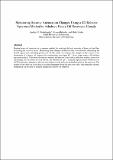| dc.contributor.author | Shabelansky, Andrey Hanan | |
| dc.contributor.author | Malcolm, Alison E. | |
| dc.contributor.author | Fehler, Michael | |
| dc.contributor.other | Massachusetts Institute of Technology. Earth Resources Laboratory | |
| dc.date.accessioned | 2014-09-30T14:42:54Z | |
| dc.date.available | 2014-09-30T14:42:54Z | |
| dc.date.issued | 2012 | |
| dc.identifier.uri | http://hdl.handle.net/1721.1/90472 | |
| dc.description.abstract | Heating heavy oil reservoirs is a common method for reducing the high viscosity of heavy oil and thus increasing the recovery factor. Monitoring these changes in the reservoir is essential for delineating the heated region and controlling production. In this study, we measure the changes in the seismic wave attenuation of a heavy oil reservoir by constructing time-lapse Q[superscript -1] factor maps using a 4D-relative spectrum method. This method estimates seismic attenuation from surface reflection seismic surveys by calculating, for each trace in each survey, the attenuation (Q[superscript -1]) using the spectral ratio (Toksoz et al. (1979)) between a reference reflector above the reservoir and a second reflector below the reservoir. The results of our study on a real data set exhibit alignment along the injection wells, indicating that seismic attenuation can be used to monitor changes in a heavy oil reservoir. | en_US |
| dc.language.iso | en_US | en_US |
| dc.publisher | Massachusetts Institute of Technology. Earth Resources Laboratory | en_US |
| dc.relation.ispartofseries | Earth Resources Laboratory Industry Consortia Annual Report;2012-25 | |
| dc.subject | 4D | |
| dc.subject | Imaging | |
| dc.title | Monitoring Seismic Attenuation Changes Using a 4D Relative Spectrum Method in Athabsca Heavy Oil Reservoir, Canada | en_US |
| dc.type | Technical Report | en_US |
